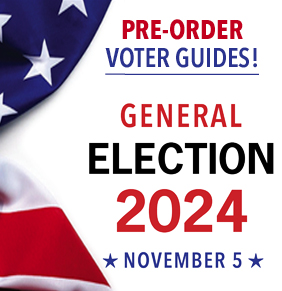Illinois on Verge of Becoming America’s Most Democratic State
Written by Russ Stewart
Illinois is an anomaly. It is “The Land of Lassitude.” Voters are passive, partisan and forgiving. In state government, there are no checks and balances to Democratic abuses, ineptitude and favoritism.
In any other state, when a governor is impeached, indicted, convicted and imprisoned, the party of that incumbent would be shamed, tarnished and ousted. Not in Illinois.
In any other state, when one party controls all the levers of government — governor, both houses of the state legislature and the supreme court — and that party fails to govern effectively, voters would hold them accountable and they would be ousted. Not in Illinois.
In any other state, when a governor raises $24 million over a 5-year period, much of it from vendors doing business with the state government, there should be an inkling of voter, media and legislative concern, if not outrage, over “pay to play.” Not in Illinois.
In any other state, when the speaker of the house, in power for 30 years, has a daughter who is the state attorney general, raises $6 million per election cycle from corporations and unions, and uses that money to elect compliant, controllable Democrats, voters would rebel. Not in Illinois.
In any other state, when a governor poses as a reformer, raises individual and corporate income taxes “temporarily,” then reneges on the promise and wants to make the increase permanent, his credibility is shot. Not in Illinois.
In any other state, when the governor ceaselessly panders to voter blocs, advocating gay marriage, driver’s licenses for illegal aliens and minimum wage hikes, but dithers on key fiscal issues, he’s a goner. Not in Illinois.
In most states, ethnic, racial, religious and cultural groupings typify the political environment. Among the more heterogeneous Democrats, intrinsic differences and rivalries occasionally contribute to the election of a Republican over an “unacceptable” Democrat. Not in Illinois. With the exception of conservative Glenn Poshard’s defeat for governor in 1998 by George Ryan, every Democratic constituency supports every Democrat.
In any other state, when the governor, faced with state debt of $44.7 billion, unfunded pensions of $85 billion, unpaid Medicaid bills of $7 billion, and the certainty that one-third ($10 billion) of the state’s annual revenue stream will be allocated to pension payments by 2017, he has a problem. When he adopts a pro-union position of no pension cuts, he’s a goner. Not in Illinois.
In any other state, where the governor and legislature constantly bicker and squabble, where the more liberal senate is constantly at variance with the more conservative house, and where the Democrats control both chambers by veto-proof super majorities (over 60 percent) of 40-19 and 71-47, one would expect voter disgust. Not in Illinois. In 2012 even more Democrats were elected to the General Assembly.
In Illinois, politicians who are mendacious, inept and felonious don’t poison the party well as long as they’re Democrats. Yet a Republican like George Ryan, who did what the Democrats have always done — extorted campaign donations from state employees — went to jail and poisoned the Republican statewide ticket in 2002. Of course, the equally disgraced Rod Blagojevich, now in federal prison, didn’t elicit anti-Democratic revulsion in 2010, when Pat Quinn kept the governorship by 31,834 votes.
Illinois’ problem, and Republican candidate Bruce Rauner’s conundrum in 2014, is that it has become an obsessively partisan state. The Republican brand is hugely unacceptable. Democratic abuses are overlooked. Minorities simply will not vote for any Republican candidate, no matter how repugnant the Democratic candidate is. Blacks are 15 percent of Illinois’ 2010 population of 12,864,380, Hispanics are 16 percent, and Asians are 5 percent, and the white population is 73 percent. That’s gives the Democrats a locked-in voter base of 20 to 25 percent. To win, a Republican needs to get 65 percent of the white vote. Unfortunately, white women vote for Democrats, usually by 60-40 margins, while white men back Republicans by 55-45.
In addition, Illinois has evolved into a city-state. The urban population in Chicago, the Cook County suburbs and the Collar Counties outnumbers the state’s other 95 counties by 2-1. More than 62 percent of the state’s registered voters are in the Chicago metropolitan area, and 38 percent are Downstate.
In virtually every other Midwestern state, politics is driven by ideology. The Republicans are the party of white conservatives from the suburbs or rural areas, and the Democrats are the party of white liberals, minorities, gays and feminists. The moderate or independent vote, usually about 15 to 20 percent, determines the outcome. That is the norm in states such as Wisconsin, Michigan, Ohio, Indiana and Iowa.
Interestingly, Illinois is not yet one of the country’s most habitual Democratic states. That distinction belongs to Hawaii, Massachusetts, Rhode Island, Vermont, Maryland and Connecticut, all of which are city-states dominated by urban Democrats, but each of which recently has elected a Republican governor to compensate for overwhelmingly Democratic legislatures. That’s “checks and balances.” Not in Illinois.
Here’s a review of a few states:
Hawaii: Nowhere is ethnic, religious and cultural factionalism more evident than in Barack Obama’s birthplace. Hawaii makes Illinois look like an oasis of tranquility. It is a prototype of America’s emerging bi-racial society, where half of all married couples are biracial. Of the general population, 42 percent are at least partly white, 57 percent are of Japanese, Chinese or Filipino heritage, and 26 percent are native Hawaiians or Pacific Islanders. Japanese Americans are dominant. There are Buddhists, Hindus, Christians and Jews. Virtually all the factions detest the Republicans.
The state’s preeminent politician was the late Daniel Inouye, a Japanese American who was a senator from 1962 to 2012 and who built the state’s Democratic machine. After becoming a state in 1959, a Republican governor was elected, but a Democrat controlled the statehouse from 1962 to 2002. Obama won the state with 71 percent of the vote in 2012. The Democrats have 24-1 and 44-7 majorities in the Senate and House. In 2002 voters rebelled and elected Jewish Republican Linda Lingle as governor. She was re-elected in 2006 but was term-limited in 2010. New York-born Congressman Neil Abercrombie won the governorship in 2010 with 58 percent of the vote, but he created a firestorm when, after Inouye’s death in 2012, he appointed white Jewish lieutenant governor Brian Schatz to the vacancy rather than Japanese-American Buddhist congresswoman Colleen Hanabusa. Now Hanabusa is challenging Schatz, and Abercrombie has a Japanese-American primary foe. It’s biracial warfare.
Honolulu’s former native Hawaiian mayor is running for governor as an independent, and the Republican candidate is Lingle’s former lieutenant governor, a Japanese American. In a three-way race, the Republican can win.
Massachusetts: Legendary for being the only state to support George McGovern in 1972 and for foisting Michael Dukakis on the Democrats in 1988, Massachusetts last voted for a Republican for president in 1956. It is a one-party state, with the Democrats up 9-0 in the congressional delegation and with legislative majorities of 36-4 in the Senate and 129-29 in the House. Obama won Massachusetts with 61 percent of the vote against the state’s former Republican governor, Mitt Romney. Yet Massachusetts had a Republican governor for 32 of the 62 years from 1952 to 2014, and continuously from 1990 to 2006. Voters are sophisticated. They intuitively understand that rapacious legislative Democrats (sounds like Illinois) need the check and balance of a Republican governor.
Rhode Island: Obama won the state with 63 percent of the vote in 2012, and the Democrats have majorities of 32-5 in the Senate and 69-6 in the House. There is no Republican presence in Providence. Yet the Democrats haven’t elected a governor since 1990. A Republican was elected in 1994, 1998, 2002 and 2006, and a liberal former Republican U.S. senator was elected as an independent in 2010. The winner in November likely will be Democratic state Treasurer Gina Raimondo, who is pro-charter schools and anti-union.
Vermont: The state boasts Bernie Sanders, a self-proclaimed socialist, as a senator. Obama won 67 percent of the vote in 2012, and the legislature is 23-7 and 97-44. Yet a Republican was the governor from 2002 to 2010 and, before Democrat Howard Dean, for many years in the 1970s and 1980s.
Maryland: Call it “Washingmore,” a true city-state comprising Baltimore and the Washington, D.C., suburbs. Illinois has had Republican governors for 38 of 62 years since 1952. In Maryland, in the 60 years since 1954, Republicans have been elected governor twice, and they served a total of 6 years. Spiro Agnew, later the disgraced vice president, won in 1966 and resigned in 1968. Bob Erlich won in 2002, defeating Bobby Kennedy’s daughter, but he lost in 2006. Obama won an astonishing 78 percent of the vote in 2012, in a state with a 31 percent black population. In November Democratic Lieutenant Governor Anthony Brown, will be elected to succeed Marty O’Malley, who is running for president.
Republican states such as Kansas, Idaho, Wyoming, Nebraska, Indiana and North Dakota occasionally elect a member of the opposite party as governor, as a reaction to an incumbent’s ineptitude. So do Democratic states Connecticut, New Jersey, Maine and Michigan.
However, if Quinn beats Rauner, Illinois arguably will rank as America’s most Democratic state.
This article was originally posted at the RussStewart.com blog.














